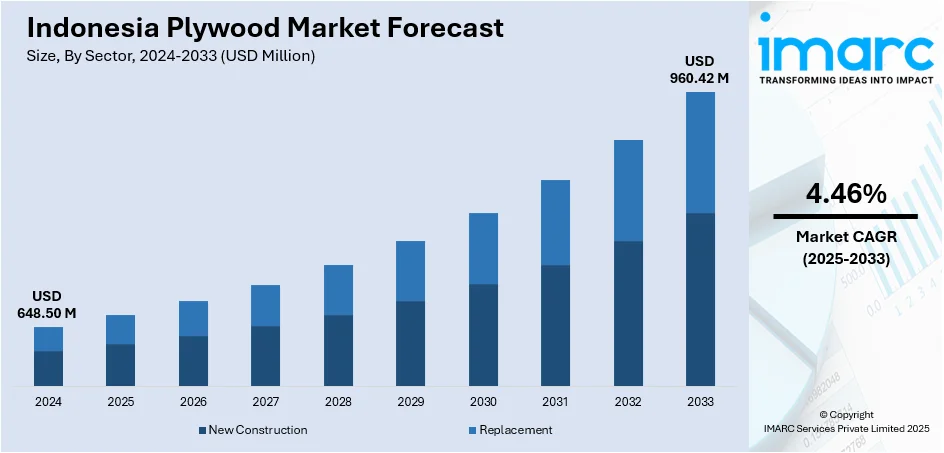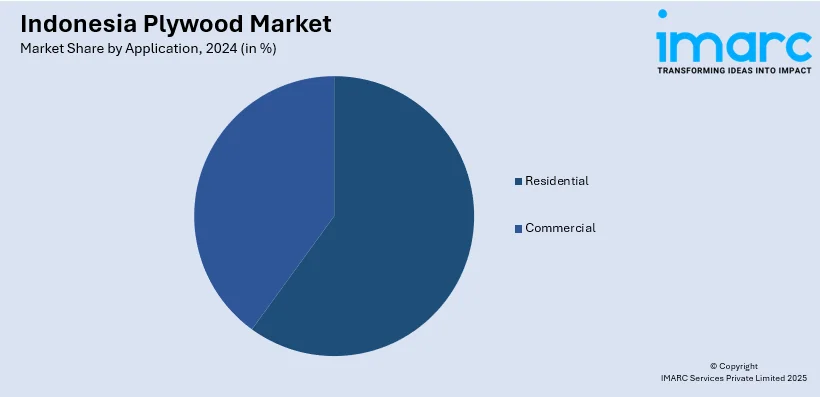
Indonesia Plywood Market Size, Share, Trends and Forecast by Application, Sector, and Region, 2025-2033
Indonesia Plywood Market Overview:
The Indonesia plywood market size reached USD 648.50 Million in 2024. The market is projected to reach USD 960.42 Million by 2033, exhibiting a growth rate (CAGR) of 4.46% during 2025-2033. Indonesia possesses a significant natural advantage in plywood manufacturing due to its extensive forest reserves, abundant in tropical hardwoods and softwoods. This convenient availability of timber is enabling manufacturers to create a diverse range of plywood varieties. Local boat builders, ferry operators, and cargo ship manufacturers rely on high-quality plywood for its performance and reliability in harsh marine environments. This is fueling the Indonesia plywood market share.
|
Report Attribute
|
Key Statistics
|
|---|---|
|
Base Year
|
2024 |
|
Forecast Years
|
2025-2033
|
|
Historical Years
|
2019-2024
|
| Market Size in 2024 | USD 648.50 Million |
| Market Forecast in 2033 | USD 960.42 Million |
| Market Growth Rate 2025-2033 | 4.46% |
Indonesia Plywood Market Trends:
Abundance of timber
The abundance of timber in Indonesia is fueling the market growth. Indonesia has a significant natural advantage in the production of plywood due to its extensive forest reserves that are abundant in tropical hardwoods and softwoods. Manufacturers are able to meet both domestic and international demand by producing a wide range of plywood kinds, including maritime, commercial, and ornamental grades, owing to the easy availability of timber. Because wood is readily available locally, production costs are lowered, making Indonesian plywood extremely competitive in international markets. Additionally, it facilitates uninterrupted production and aids in effectively fulfilling high-volume export orders. Since many plywood manufacturers are situated close to forested regions, supply chain speed is increased and transportation costs are minimized. Furthermore, the vast range of wood species enables innovations and the creation of specialty plywood products. The large quantity of timber also encourages international investments in wood processing facilities. With efficient forestry management practices and increasing adoption of legal and sustainable harvesting, Indonesia balances economic benefit with environmental responsibility. Moreover, as the country continues to export forestry products, the plywood market will grow steadily. As per the Indonesian Ministry of Forestry, the export value of products from the forestry sector in 2024 was USD 11.896 Billion.

To get more information on this market, Request Sample
Growing marine and shipping needs
Rising marine and shipping needs are impelling the Indonesia plywood market growth. As an archipelagic country with thousands of islands, Indonesia depends heavily on marine transport for goods and people, creating the need for plywood in shipbuilding, boat interiors, and port infrastructure. Marine-grade plywood is widely used in vessel flooring, walls, furniture, and compartments due to its resistance to moisture, salt, and wear. Local boat builders, ferry operators, and cargo ship manufacturers rely on high-quality plywood for its performance and reliability in harsh marine environments. Additionally, ports and coastal infrastructure projects employ plywood for formwork and temporary structures. As the marine and shipbuilding industry continue to expand, plywood remains a key material. As per industry reports, in 2028, the Indonesia shipbuilding sector is projected to reach a volume of 52,300 gross Tonnage, representing a 16.8% rise compared to 2023. This consistent demand from the marine and shipping industry is contributing significantly to the growth and stability of the market.
Increasing logistics activities
As the movement of goods is growing across Indonesia’s islands and to international markets, logistics companies continue to rely on plywood for pallets, crates, containers, and protective transport structures. Plywood’s durability and light weight make it ideal for handling heavy and fragile items during shipping. Warehouses and distribution centers also use plywood for shelving, flooring, and partitioning. With the rise of e-commerce and regional trade, the demand for efficient and secure packaging solutions continues to grow, further boosting plywood utilization. As per the IMARC Group, the Indonesia e-commerce market size was valued at USD 354.6 Billion in 2024. In addition, plywood’s availability and affordability in Indonesia make it a preferred material in logistics operations. As supply chains are modernizing, plywood remains essential, supporting the steady growth of the market.
Indonesia Plywood Market Segmentation:
IMARC Group provides an analysis of the key trends in each segment of the market, along with forecasts at the country and regional levels for 2025-2033. Our report has categorized the market based on application and sector.
Application Insights:

- Residential
- Commercial
The report has provided a detailed breakup and analysis of the market based on the application. This includes residential and commercial.
Sector Insights:
- New Construction
- Replacement
A detailed breakup and analysis of the market based on the sector have also been provided in the report. This includes new construction and replacement.
Regional Insights:
- Java
- Sumatra
- Kalimantan
- Sulawesi
- Others
The report has also provided a comprehensive analysis of all the major regional markets, which include Java, Sumatra, Kalimantan, Sulawesi, and others.
Competitive Landscape:
The market research report has also provided a comprehensive analysis of the competitive landscape. Competitive analysis such as market structure, key player positioning, top winning strategies, competitive dashboard, and company evaluation quadrant has been covered in the report. Also, detailed profiles of all major companies have been provided.
Indonesia Plywood Market Report Coverage:
| Report Features | Details |
|---|---|
| Base Year of the Analysis | 2024 |
| Historical Period | 2019-2024 |
| Forecast Period | 2025-2033 |
| Units | Million USD |
| Scope of the Report |
Exploration of Historical Trends and Market Outlook, Industry Catalysts and Challenges, Segment-Wise Historical and Future Market Assessment:
|
| Applications Covered | Residential, Commercial |
| Sectors Covered | New Construction, Replacement |
| Regions Covered | Java, Sumatra, Kalimantan, Sulawesi, Others |
| Customization Scope | 10% Free Customization |
| Post-Sale Analyst Support | 10-12 Weeks |
| Delivery Format | PDF and Excel through Email (We can also provide the editable version of the report in PPT/Word format on special request) |
Key Questions Answered in This Report:
- How has the Indonesia plywood market performed so far and how will it perform in the coming years?
- What is the breakup of the Indonesia plywood market on the basis of application?
- What is the breakup of the Indonesia plywood market on the basis of sector?
- What is the breakup of the Indonesia plywood market on the basis of region?
- What are the various stages in the value chain of the Indonesia plywood market?
- What are the key driving factors and challenges in the Indonesia plywood market?
- What is the structure of the Indonesia plywood market and who are the key players?
- What is the degree of competition in the Indonesia plywood market?
Key Benefits for Stakeholders:
- IMARC’s industry report offers a comprehensive quantitative analysis of various market segments, historical and current market trends, market forecasts, and dynamics of the Indonesia plywood market from 2019-2033.
- The research report provides the latest information on the market drivers, challenges, and opportunities in the Indonesia plywood market.
- Porter's five forces analysis assist stakeholders in assessing the impact of new entrants, competitive rivalry, supplier power, buyer power, and the threat of substitution. It helps stakeholders to analyze the level of competition within the Indonesia plywood industry and its attractiveness.
- Competitive landscape allows stakeholders to understand their competitive environment and provides an insight into the current positions of key players in the market.
Need more help?
- Speak to our experienced analysts for insights on the current market scenarios.
- Include additional segments and countries to customize the report as per your requirement.
- Gain an unparalleled competitive advantage in your domain by understanding how to utilize the report and positively impacting your operations and revenue.
- For further assistance, please connect with our analysts.
 Request Customization
Request Customization
 Speak to an Analyst
Speak to an Analyst
 Request Brochure
Request Brochure
 Inquire Before Buying
Inquire Before Buying




.webp)




.webp)












